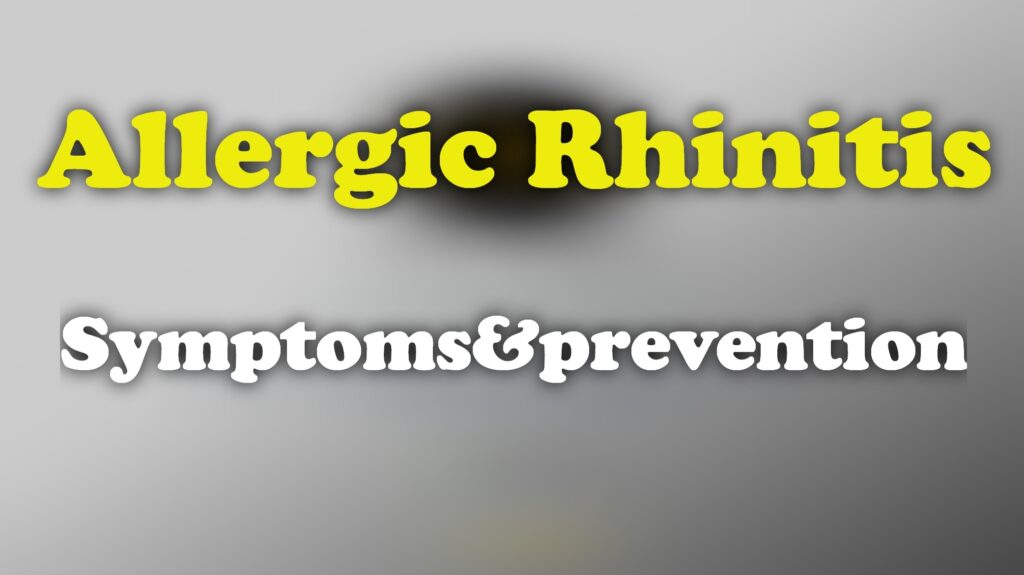Allergic rhinitis, also known as hay fever, is a allergic reaction that causes sneezing, congestion, itchy nose and sore throat. Pollen, pet dander, mold and insects can lead to hay fever symptoms. Hay fever can make you feel awful, but you can find relief with lifestyle changes, allergy medications.Here we are checking how to prevent allergic rhinitis symptoms effectively
Allergic rhinitis (hay fever) is an allergic reaction to tiny particles in the air called allergens. When you breathe in allergens enter to your respiration through your nose or mouth, your body reacts by releasing a natural chemical called histamine. Several indoor and outdoor allergens cause hay fever. Common causes include dust mites, mold, pet dander and pollen from trees and plants.
▶️When do people usually get hay fever?
You can have hay fever any time of the year. Seasonal allergies occur in the spring, summer and early fall when trees and weeds bloom and pollen counts are higher. Perennial allergies can happen year-round. They result from irritants that are always around, such as pet dander, cockroaches and dust mites.
❔How common is allergic rhinitis (hay fever)?
Hay fever is very common.Millions of children and adults have hay fever every year.
❔Who might get allergic rhinitis?
Allergies are genetically passed down through families). You’re more likely to have hay fever if you have a parent or family member with allergies. People who have asthma or eczema are more likely to develop hay fever.
✴️SYMPTOMS AND CAUSES
Allergic rhinitis occurs when your body’s immune system reacts to an irritant in the air. The irritants (allergens) are so tiny that you can easily inhale them through your nose or mouth.
Allergens are harmless to most people. But if you have hay fever, your immune system thinks the allergen is intruding. The immune system tries to protect your body by releasing natural chemicals into your bloodstream. The main chemical is called histamine. It causes mucous membranes in the nose, eyes and throat to become inflamed and itchy as they work to eject the allergen.
Seasonal and perennial allergies can result from many allergens, including:
➡️Dust mites that live in carpets, drapes, bedding and furniture.
➡️Pollen from trees, grass and weeds.
➡️Pet dander (tiny flakes of dead skin).
➡️Mold spores.
➡️Cockroaches, including their saliva and waste.
➡️Food allergies can also cause inflammation in the nose and throat. If you think you’re having an allergic reaction to something you ate, get medical help right away.
▶️Symptoms of allergic rhinitis
Hay fever symptoms can appear throughout the year. Outdoor allergies are worse in the spring, summer and early fall. In warm weather, weeds and flowers bloom, and pollen counts are higher.
Indoor allergies, such as those that result from pet dander and dust mites, can get worse in winter because people spend more time indoors.
➡️Nasal stuffiness (congestion), sneezing and runny nose.
➡️Itchy nose, throat and eyes.
➡️Headaches, sinus pain and dark circles under the eyes.
➡️Increased mucus in the nose and throat.
➡️Fatigue and malaise (general feeling of discomfort).
➡️Sore throat from mucus dripping down the throat (postnasal drip).
➡️Wheezing, coughing and trouble breathing.
❔What is a skin prick test?
This common test is painless and accurate, though it may be a little uncomfortable. Your examiner places a small sample of different allergens on your skin (usually on your forearm or back) and scratches or pricks the skin with a needle. Scratching the skin allows the allergen to get under the surface.
If you’re allergic to the allergen, the area will become red, itchy and irritated in 15 to 30 minutes. You may develop raised, hive-like welts called wheals that show an allergic reaction. A skin prick test is a safe, effective way to determine which allergens are causing your symptoms.
🔅MANAGEMENT AND TREATMENT OF ALLERGIC RHINITIS
Several allergy medications can improve symptoms and help you live with hay fever. These treatments come in many forms, including liquids, pills, eye drops, nasal sprays and injections
🚷Prevention of allergic rhinitis
There is no way to prevent hay fever, but lifestyle changes can help you live with allergies. You can relieve hay fever symptoms by avoiding irritants as much as possible. To reduce symptoms, you should:
➡️Avoid touching your face and rubbing your eyes or nose.
➡️Close windows in your home and car during the spring, summer and early fall when pollen counts are higher.
➡️Enclose pillows, mattresses and box springs in dust mite covers.
➡️Keep pets off couches and beds, and close doors to bedrooms you don’t want them to enter.
➡️Use filters in your vacuum cleaner and air conditioner to reduce the amount of allergens in the air.
➡️Wash your hands often, especially after playing with pets.
➡️Wear a hat and sunglasses to protect your eyes from pollen when you’re outside. Change your clothes as soon as you come indoors.
⚠️People with airborne allergies have a higher risk of ear infections and sinus infections. Because hay fever can make it tough to get a good night’s sleep, you may feel tired during the day. If you have asthma, hay fever can make your asthma symptoms worse.

